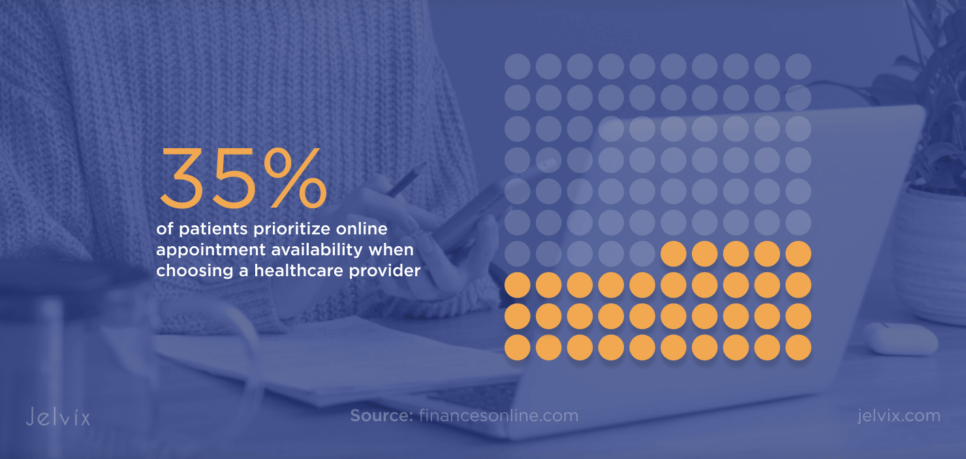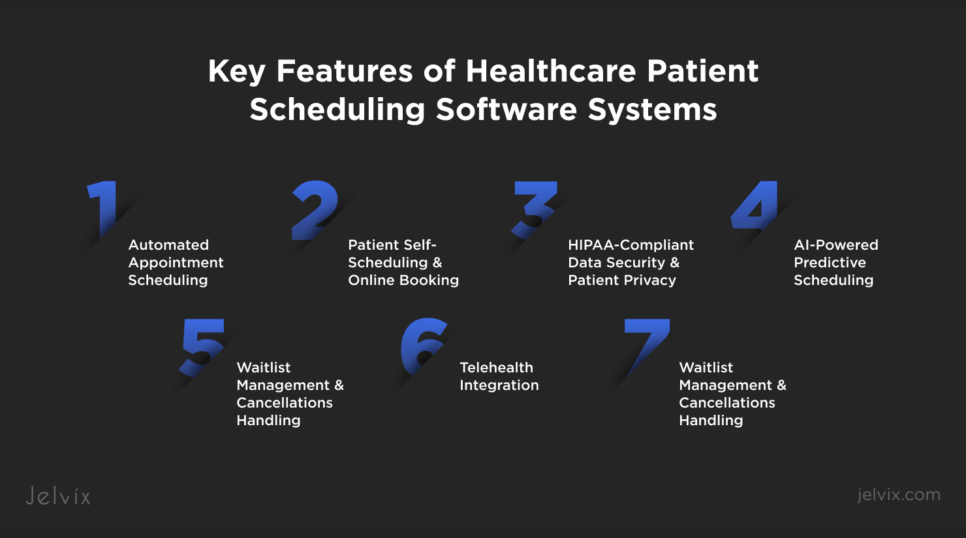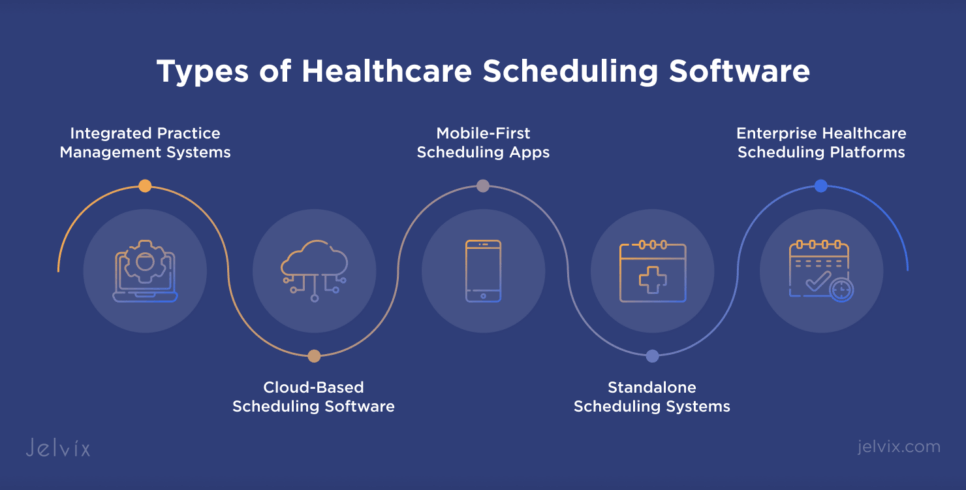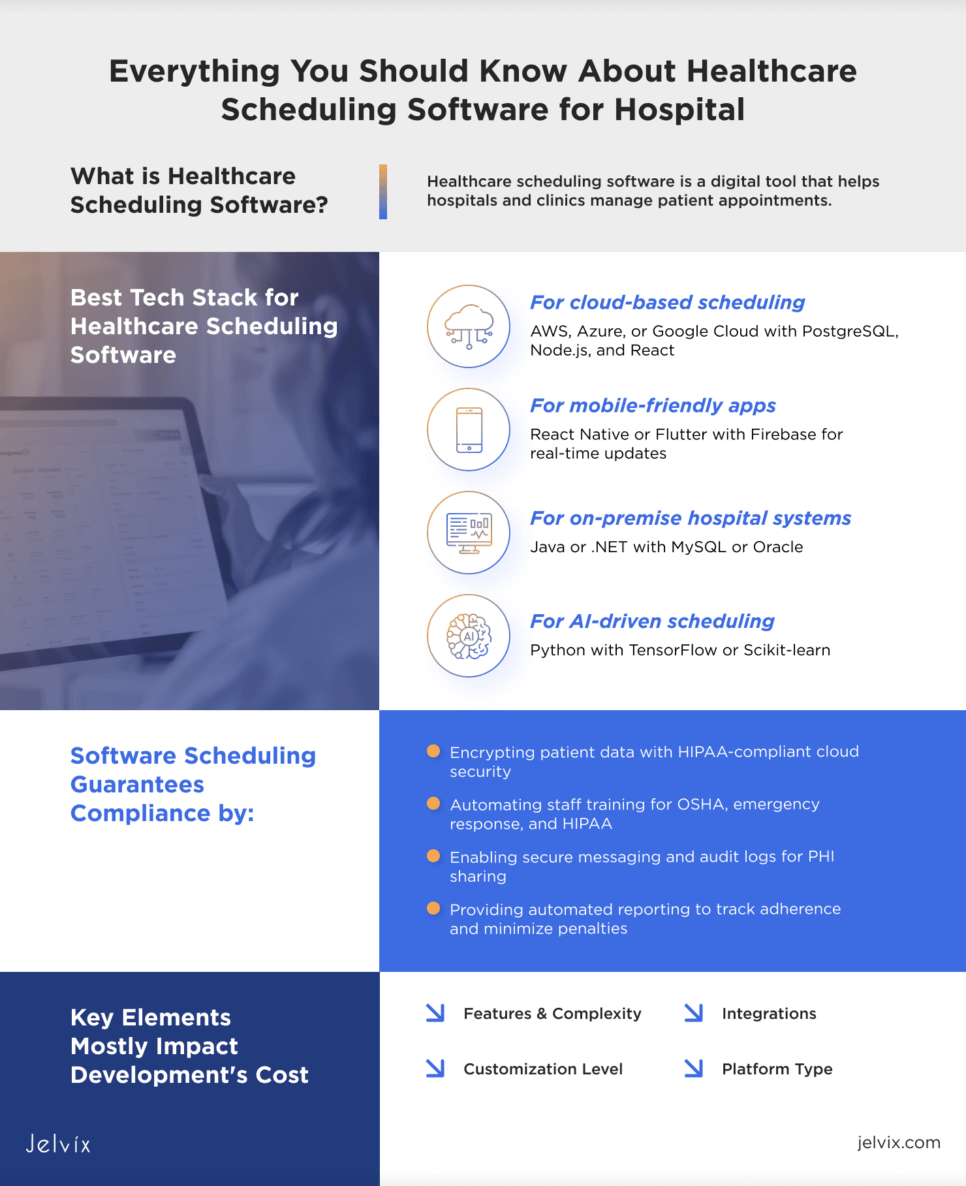Manually scheduling appointments is a logistical mess. Without automating tools:
- Health clinics face a 19% no-show rate, compared to just 3% for those using automated scheduling;
- 28% of patients have switched or stopped visiting a provider due to poor online booking experiences;
- 35% of patients prioritize online appointment availability when choosing a healthcare provider.
Continually, with the rise of chronic diseases and a shortage of medical professionals, hospitals are under increasing pressure. The U.S. will run low on up to 124,000 doctors by 2034. Cancer (1.95 million new U.S. cases in 2023) and heart disease (620 million cases worldwide) call for improved chronic disease management and patient care practices.
Hospitals are looking for smart scheduling solutions to help with these difficulties. In August 2022, Kyruus teamed up with Christus Health to create a modern digital directory that enhanced patient-provider matching. Likewise, in March 2022, WellHive partnered with Kyruus to improve Veteran Health Administration (VHA) scheduling.
Patient scheduling software is no longer a luxury; as the demand for efficiency and accessibility increases, it becomes a necessity. In this post, we will discuss the basic principles, advantages, and factors hospitals should consider when deciding on the appropriate platform.
What is Healthcare Scheduling Software?
Manual appointment management can cause administrative overload, long wait times, and scheduling conflicts. Healthcare scheduling software is a digital tool that helps hospitals and clinics manage patient appointments. Automated reminders and simple rescheduling tools reduce no-show rates. Real-time availability lets patients schedule convenient times. Clients can plan treatment when they need it instead of coping with annoying phone calls and delays, raising general satisfaction.
Clinic scheduling software helps medical staff members plan shifts, visit patients, and distribute resources. It guarantees improved coordination, lowers errors, improves time management, and eliminates manual scheduling chores. Less administrative work lets doctors and nurses concentrate on providing excellent patient care.
AI-driven scheduling software for hospitals advances this by forecasting peak hours, optimizing schedules, lowering patient wait times, and evaluating appointment trends. It also provides automatic reminders to reduce missed appointments and helps people be matched with appropriate doctors.
Benefits of Healthcare Scheduling Software
There is no one-size-fits-all medical appointment scheduling software since different medical practices vary in size and operation. Every practice has to assess the possibilities to choose the finest patient scheduling program for their particular requirements. Still, whatever online patient scheduling tool is chosen, it should be able to provide at least the following typical advantages.
Improved Patient Experience and Satisfaction
Making an appointment shouldn’t be troublesome. Self-scheduling choices free patients from depending on limited office hours, waiting on hold, or visiting in person. The possibility to book, reschedule, cancel, or check availability at any moment gives healthcare access more adaptability. Those with hectic schedules, language problems, or mobility limitations especially benefit from this degree of control. Many sites now have HIPAA-compliant messaging, which lets patients interact directly with clinicians, get test results, request paperwork, or clarify medical instructions—all without ever visiting a clinic.
Reduction in No-Shows and Missed Appointments
Missed appointments are a major issue for healthcare providers, leading to wasted time and revenue loss. By keeping patients informed, automated reminders and confirmations greatly help minimize no-shows. According to 2020 Sign In Solutions Inc. data, clinics using scheduling software have a 3% no-show rate; those depending on manual scheduling have an astonishing 19%. Furthermore, 40% of online medical appointments are booked for the same or the next day, which shows how quickly digital booking is promoted. Hospitals can thus maximize appointment availability, boost efficiency, and avoid needless gaps in patient care.
Better Resource Allocation and Staff Management
Medical facilities suffer inefficiencies from overworked doctors, unbalanced timetables, and vacant time slots. Software for healthcare staff scheduling solves these problems by filling last-minute cancellations, preventing overbooking. AI-driven systems examine scheduling trends and notify waiting patients when an earlier appointment becomes available.
Enhanced Efficiency and Revenue Optimization
Missed payments and ineffective scheduling cost healthcare facilities money. Every missed appointment or delayed payment accumulates and strains cash flow. Clinic scheduling software connects with billing systems to address this problem head-on and generates a flawless system in which payments and scheduling coexist.
Automated appointment-based billing allows hospitals to send timely payment reminders, lowering the possibility of overdue accounts. Features like card-on-file transactions guarantee providers are paid on time and help patients make payments easily. These systems also monitor outstanding balances and automatically follow up, maintaining orderly financial records without burdening front-desk employees.
Digital scheduling reduces administrative waste and enhances cash flow. Reducing documentation, manual errors, and billing inefficiencies saves time and money, enabling hospitals to become more financially stable and efficient.
Compliance with Healthcare Regulations (HIPAA and Beyond)
Beyond mere operational effectiveness, regulatory compliance depends much on healthcare scheduling systems. HIPAA, OSHA, emergency preparedness, and other healthcare regulations must be followed by hospitals and clinics—all of which necessitate safe data management and structured workflows. Software scheduling guarantees compliance by:
- Encrypting patient data with HIPAA-compliant cloud security to prevent breaches.
- Automating staff training schedules to meet OSHA, emergency response, and HIPAA requirements without disrupting daily operations.
- Providing secure messaging and audit logs, allowing safe sharing of Protected Health Information (PHI) while keeping records for compliance checks.
- Offering automated reporting tools that assist in tracking regulatory adherence and reducing the risk of penalties.
Healthcare professionals preserve data security and regulatory integrity by cutting out manual compliance work.
Prioritization of Urgent Care Needs
While emergencies call for quick response, manually rearranging plans to fit critical circumstances takes time and increases the risk of mistakes. AI-powered scheduling systems automatically rank important events by altering non-urgent appointments and contacting impacted patients.
Through automated rescheduling and multi-channel notifications—text, email, push alerts—these solutions guarantee that urgent cases get the required care without causing disturbance to other patients. Hospitals that handle this process easily can better manage high-priority cases and increase response times.
Minimized Patient Wait Times
Nobody likes waiting at a doctor’s office. Long waits irritate patients and surely put tension on the staff. Smart scheduling tools reduce wait times by forecasting peak hours, maximizing physician availability, and modifying appointment flow. With fairly spread patient visits throughout the day, AI-driven scheduling solutions help avoid crowding. These instruments become even more important in hospitals with personnel shortages since they guarantee efficient resource use and high-quality treatment.
Key Features of Healthcare Patient Scheduling Software Systems
Although scheduling software for healthcare may have several purposes, most of them include the necessary capabilities for automating appointment booking and keeping your company afloat in multiple ways.
Automated Appointment Scheduling
Medical institutions can be overwhelmed with long phone calls, last-minute booking problems, personnel inefficiencies, and lost income possibilities. Using AI-powered reasoning to match patient needs with provider availability, healthcare staff scheduling systems automate the booking process. Before allocating a time slot, the algorithm factors in appointment types, necessary medical resources, provider specialties, and patient preferences.
This approach maximizes daily appointment capacity and increases operational effectiveness while avoiding scheduling conflicts.
Real-Time Availability & Calendar Synchronization
Hospitals run the danger of double reservations, appointment conflicts, empty remaining slots, and poor resource allocation without real-time scheduling updates. Medical staff scheduling software coordinates multiple locations to guarantee precise availability for:
- primary care, specialty departments, urgent care, and surgical units;
- multi-provider practices, group consultations, and telehealth visits;
- diagnostic services like lab tests, imaging, and physical therapy;
- hospital rooms, treatment spaces, and mobile healthcare units.
By integrating with EHR (Electronic Health Records), hospital management systems, and external scheduling platforms, the system shares live updates on provider availability and prevents over-scheduling or underutilization of resources.
Patient Self-Scheduling & Online Booking
When people make appointments, they want quick booking confirmation, simple access, and flexibility. Without visiting the hospital or phoning, the patient scheduling system lets them book, reschedule, cancel, or check real-time availability. Other patient-friendly features consist of:
- Appointment reminders via SMS, email, app notifications, or voice calls;
- Multiple provider selection options based on specialization, location, or language;
- Insurance verification and automated eligibility checks before booking;
- Pre-appointment digital check-ins and secure document submission.
Telehealth Integration
With the rise of virtual care and home-based consultations, hospital scheduling software must support seamless telehealth integration. Patients can book virtual visits directly through the system, which then:
- Generates encrypted video conferencing links with EHR access;
- Automatically assigns telehealth slots based on provider availability and case urgency;
- Enables remote patient monitoring integration for chronic disease management;
- Supports multi-specialist virtual consultations and referral coordination.
See how our end-to-end telehealth solution drives down no-show rates and maximizes scheduling efficiency.
AI-Powered Predictive Scheduling
AI-driven scheduling goes beyond simple appointment booking. It anticipates patient demand, optimizes provider utilization, and dynamically adjusts scheduling workflows. It uses predictive analytics to:
- Identify peak patient flow hours and allocate staff accordingly;
- Analyze seasonal trends, high-demand specialties, and resource constraints;
- Automate scheduling adjustments based on historical data and real-time cancellations;
- Fill appointment gaps by contacting patients from the waitlist in real time;
- Balance physician workloads to prevent burnout and optimize shift rotations.
Waitlist Management & Cancellations Handling
Though they are inevitable, missed appointments don’t always equal wasted time. Healthcare staff scheduling programs help minimize revenue losses by automatically offering canceled slots to waitlisted patients. Patients can promptly accept or reject new time slots by text, email, push alerts, or in-app updates. This system keeps schedules full while preventing last-minute disruptions.
HIPAA-Compliant Data Security & Patient Privacy
Patient data security is a top priority in digital healthcare development. Scheduling software for healthcare ensures HIPAA, GDPR, and HITRUST compliance through:
- End-to-end encryption for all communications, records, and transactions;
- Multi-factor authentication (MFA) for secure provider access;
- Role-based user access control;
- Automated audit logs;
- Cloud-based storage with redundancy.
From automating staff schedules to minimizing patient wait times, modern healthcare scheduling software systems improve hospital workflows, reduce inefficiencies, and enhance patient experiences. As healthcare moves toward digital-first operations, investing in intelligent solutions is essential for efficient hospital management.
Types of Healthcare Scheduling Software
Depending on their requirements, healthcare professionals apply several scheduling systems. The correct option enhances efficiency and patient care, whether it’s a tiny clinic handling basic visits or a hospital managing several divisions.
Standalone Scheduling Systems
Best for small clinics requiring basic appointment management without complex features. These systems handle:
- Online booking with real-time availability;
- Automated reminders via SMS, email, or app notifications;
- Simple rescheduling and cancellation handling to reduce no-shows.
They do not integrate with EHR or billing platforms, making them suitable for providers needing only a scheduling tool.
Integrated Practice Management Systems
Ideal for medium to large practices, these systems combine scheduling with:
- Patient scheduling and reminders;
- Billing, invoicing, and insurance processing;
- EHR access directly from the scheduling dashboard;
- Resource management for staff, rooms, and equipment.
Enterprise Healthcare Scheduling Platforms
Designed for hospitals and multi-location providers, these systems support:
- Multi-department and multi-location scheduling;
- Specialist and diagnostic service coordination;
- Optimized staff scheduling to reduce physician burnout;
- AI-driven patient flow management for real-time adjustments.
They handle high patient volumes and complex scheduling needs across large networks.
Cloud-Based Scheduling Software
A flexible solution that runs entirely online, allowing:
- Access from any device with internet connectivity;
- Automatic updates and security patches with minimal IT maintenance;
- Scalability for growing practices or multi-location providers.
Cloud-based systems integrate easily with EHR, billing, and patient portals while ensuring secure data storage.
Mobile-First Scheduling Apps
Patient self-scheduling software provides:
- Instant appointment booking and availability updates;
- Digital check-in to reduce waiting times;
- GPS-integrated navigation for easy facility access;
- In-app messaging for direct provider communication.
With mobile usage increasing, mobile-friendly scheduling is becoming essential for modern healthcare.
Potential Barriers to Implementing Scheduling Software
Although using healthcare scheduling systems has several advantages, hospitals and clinics could run against challenges during deployment. Knowing about possible problems helps companies get ready for a more seamless integration and better adoption.
High Initial Investment Costs
Particularly for big healthcare providers, switching from manual scheduling or outdated technology calls for considerable upfront expenses. On average, cloud-based scheduling software can cost between $1,500 and $10,000 per year per provider, while enterprise-level systems may exceed $100,000 for implementation, licensing, and customization.
Beyond software costs, hospitals must invest in:
- Hardware upgrades, including secure servers and workstations;
- Training programs for medical and administrative staff;
- IT support and maintenance to manage software updates and security.
Even with the costs involved, long-term savings from fewer scheduling mistakes, less administrative effort, and improved patient management usually exceed early expenses.
Staff Resistance to Adopting New Technology
Many healthcare workers are accustomed to traditional scheduling methods. It’s only natural that they are hesitant to switch. Common concerns include:
- Lack of training, leading to frustration with new workflows;
- Fear of job replacement, especially among administrative staff;
- Time pressure, as learning new software takes time away from patient care.
Hospitals should offer hands-on training, user-friendly interfaces, and phased rollouts to enable staff members to change gradually and increase adoption. Customizable dashboards and AI-powered assistants also help ease the use of new systems.
Integration Challenges with Existing Hospital Systems
Integration is one of the nightmares for developers and IT teams in deploying healthcare appointment scheduling software. Hospitals rely on a mix of independent systems: EHRs, billing and insurance verification platforms, Hospital Information Systems (HIS), and patient portals. With all this on board, common technical issues during the integration phase include:
- Data inconsistencies, where formats don’t match between systems (e.g., EHR uses XML, but scheduling software processes JSON).
- API limitations, where legacy systems have restricted data-sharing capabilities or require custom middleware.
- Latency issues, where real-time scheduling updates fail due to slow data synchronization.
- Security risks, as integrating third-party software increases exposure to data breaches and cyber threats.
Successful integration calls for strong API management, HL7 and FHIR interoperability standards, and data validation techniques to guarantee flawless system connection.
Data Security and Compliance Concerns
Handling patient health information (PHI) means strict security measures must be in place. Hospitals must comply with:
- HIPAA (U.S.): Ensures data encryption, role-based access, and audit logging.
- GDPR (EU): Protects patient privacy and data control rights.
- HITRUST & SOC 2: Verifies security framework compliance for cloud-based solutions.
Security risks hospitals must mitigate include:
- Unauthorized access requires multi-factor authentication (MFA) and user role permissions.
- Data leaks are prevented by end-to-end encryption and intrusion detection systems.
- System downtime can be reduced by disaster recovery plans and backup protocols.
By addressing these issues early, hospitals can maximize the benefits of scheduling software while minimizing disruptions to patient care.
Custom Patient Scheduling Software vs. Ready-Made Software: Which One To Choose?
The decision to choose between ready-made solutions and custom-built scheduling software hinges on hospital’s requirements for control, flexibility, and scalability. While ready-made solutions offer quick implementation and lower initial costs, they also come with limitations. In contrast, custom software is tailored to align with the specific processes of a hospital.
A custom-built system guarantees perfect interaction with EHR, billing, and hospital management systems for big hospitals with complicated scheduling requirements. It permits customizable workflows, enhanced automation, and total data security management.
Nevertheless, depending on the system’s intricacy, custom development can cost anywhere from $50,000 to $500,000+. Despite being costly upfront, a customized solution provides long-term savings, scales with the institution’s demands, and removes inefficiencies.
Conversely, a speedier and more affordable choice is ready-made scheduling software. Using subscription models ranging from $1,500 to $10,000 annually per provider, cloud-based solutions can be implemented in days or weeks. Small to medium-sized clinics that don’t need much customizing will find these systems perfect since they include pre-built capabilities such as online booking, automated reminders, and HIPAA and GDPR compliance, These solutions might, however, lack adaptability, which would make them challenging to fit with certain workflows or legacy hospital systems.
Growing patient volumes might cause inefficiencies and workarounds resulting from off-the-shelf technology’s limits, raising running costs.
Custom solutions are the preferable investment for hospitals wanting complete integration and long-term scalability. If speed, cost, and simplicity of use are your top concerns, a ready-made platform offers a quick approach to update scheduling with the least disturbance. The right choice depends on the hospital’s complexity, budget, and long-term goals.
Steps To Create a Custom Healthcare Scheduling Software
Every hospital has different scheduling requirements, so the first step is to define basic features. The program should guarantee real-time calendar updates and automatic reminders while enabling AI-driven automation, multi-provider collaboration, patient scheduling features, and seamless telehealth integration.
The tech stack depends on the hospital’s size, infrastructure, and deployment needs:
- For cloud-based scheduling (scalability, remote access): AWS, Azure, or Google Cloud with PostgreSQL, Node.js, and React.
- For mobile-friendly apps (patient-first experience): React Native or Flutter with Firebase for real-time updates.
- For on-premise hospital systems (maximum data security): Java or .NET with MySQL or Oracle.
- For AI-driven scheduling (predictive analytics, automation): Python with TensorFlow or Scikit-learn.
Scheduling systems must meet HIPAA, GDPR, and HITRUST security criteria since they manage Protected Health Information (PHI). Audit logs, end-to-end encryption, and role-based access control (RBAC) guarantee patient data stays safe. Regular compliance updates help hospitals to keep ahead of legislative changes.
A good interface makes scheduling intuitive for both patients and hospital staff. Key UI/UX elements include:
- Drag-and-drop scheduling for quick appointment adjustments;
- Color-coded calendar views for different providers and departments;
- Mobile-responsive design for patient self-booking on smartphones;
- Voice and chatbot support to assist patients in scheduling via AI.
However, even the best-designed software must integrate smoothly with existing hospital systems. Without an appropriate connection to EHR systems like Epic, Cerner, or Meditech, scheduling conflicts and inefficiencies result. APIs, middleware solutions, FHIR, and HL7 interoperability standards assist in linking legacy systems with modern scheduling platforms, ensuring real-time synchronization between patient records, provider availability, and billing systems.
Extensive testing and a controlled pilot deployment are essential. Before launching, the software must go through:
- Load testing to handle high appointment volumes;
- Security audits to ensure compliance and data protection;
- Pilot rollouts in select departments for real-world testing.
Feedback from doctors, nurses, and administrators helps refine workflows before full deployment.
Talking about workers, hospital staff must feel secure utilizing the system even with a flawless rollout. Step-by-step documentation, training courses, and hands-on workshops ensure medical team members and administrative departments can use the new system. Starting with one department and then extending hospital-wide lets staff members acclimate without overloading everyday operations.
A responsive IT helpdesk and on-demand support further ease the transition. When all these elements come together, specialized healthcare scheduling systems improve hospital efficiency.
How Much Does It Cost To Develop a Healthcare Scheduling Software System?
While developing healthcare patient scheduling systems, multiple factors can influence the overall cost. Among these are the complexity of the application, design quality, and feature integration. Particularly, the following key elements mostly impact development’s cost:
- Features & Complexity: Basic scheduling with online booking and reminders typically ranges from $30,000 to $80,000. Advanced AI scheduling, real-time staff management, predictive analytics, and support for multiple locations can cost over $200,000.
- Integrations: Linking existing systems may add $20,000 to $100,000, depending on the availability of APIs and customization.
- Platform Type: Web-based software usually costs between $50,000 and $150,000. Creating mobile apps for iOS and Android increases this by $30,000 to $80,000, particularly if built using React Native or Flutter for cross-platform use.
- Customization Level: A fully customized system that includes scalability, unique workflows, and advanced automation can require a budget of $200,000 to $500,000 or more.
Creating a simple scheduling system with online booking and reminders takes three to six months. Plan for six to twelve months for a platform with EHR integration, analytics, and telemedicine capabilities. Development for enterprise requires six to twelve months. Development with multi-location management, real-time staff collaboration, and AI-powered scheduling might take 12 to 18 months.
The Smart Way to Choose – Download Your Guide to Selecting the Right Healthcare Tech Partner!

Conclusion
Scheduling systems that go beyond simple appointment booking are especially important for hospitals with large patient loads, staffing shortages, and operational inefficiencies. Modern solutions utilize online self-scheduling and integrate telehealth to enhance patient access. They automate reminders and optimize provider schedules through AI-driven predictions, which helps in reducing no-shows. A well-built system not only saves time but also increases income. It achieves this by closing scheduling gaps, lowering the administrative burden, and ensuring the best use of available resources.
Off-the-shelve solutions, however, can lack adaptability, struggle with EHR integration, and cannot scale with hospital demand. This is where Jelvix can help. We create custom scheduling programs specifically for the procedures used in your facility. Our staff guarantees compliance with HIPAA, GDPR, and HITRUST to maintain data security, implements AI-driven automation to maximize staff and patient flow, and provides flawless interoperability with Epic, Cerner, Meditech, and other hospital systems.
Jelvix can help if your hospital needs a future-ready scheduling system that increases efficiency and expands with your demands. Contact us right now for a consultation, and let’s create a system that really fits your hospital.
FAQ
Can healthcare scheduling software handle multi-location hospital networks?
Advanced scheduling systems enable hospitals and healthcare networks to easily coordinate staff, resources, and appointments. This coordination occurs across several sites, supporting multi-location management.
What are the common mistakes hospitals make when implementing scheduling software?
Among the most common mistakes are:
- Choosing a system without scalability.
- Neglecting integration with current EHR systems.
- Improperly training staff members.
- Undervaluing patient adoption issues.
How does AI improve hospital scheduling systems?
AI-powered scheduling software uses historical data and real-time analytics to forecast appointment demand. It maximizes time slots, lowers patient no-shows, and distributes resources more effectively.
Is it possible to integrate scheduling software with existing hospital management systems?
Yes, most modern scheduling systems guarantee seamless data flow and operational efficiency by including API integrations with EHR, practice management, and billing systems.
What industries besides hospitals can benefit from scheduling software?
Healthcare scheduling systems are used in hospitals, private clinics, dentistry offices, mental health practices, rehabilitation facilities, and telemedicine providers.
Need high-quality professionals?
Own the dedicated development team of professionals exclusively for your project.














